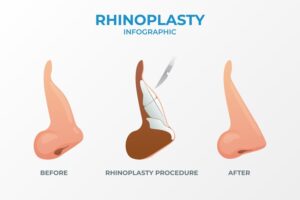Rhinoplasty, commonly known as a nose job, is a surgical procedure to alter the shape or improve the function of the nose. It can address issues such as a crooked nose, bumps, or breathing problems. The surgery involves reshaping the nasal bone and cartilage to achieve the desired outcome. Patients may seek rhinoplasty for cosmetic reasons or to correct structural defects from birth or injury. Recovery typically involves swelling and bruising, with final results visible after several months. It’s crucial to choose an board certified plastic surgeon for optimal results and minimal complications.

Techniques in Rhinoplasty
- Open Rhinoplasty :- In open rhinoplasty, an incision is made across the columella (the tissue between the nostrils) allowing the surgeon to lift the skin and have a clear view of the nasal structures. This technique is often used for more complex surgeries, providing greater precision and control.
- Closed Rhinoplasty – In closed rhinoplasty, all incisions are made within the nostrils. This technique leaves no visible scars and generally involves a shorter recovery period. It’s suitable for patients needing minor adjustments to the nasal structure.
- Septorhinoplasty:- This technique addresses both the cosmetic and functional aspects of the nose. It’s particularly useful for patients with a deviated septum or other breathing issues. The surgery corrects the nasal passage while also reshaping the nose.
- Tip Rhinoplasty:- Focusing solely on the tip of the nose, this technique reshapes the nasal tip for a more refined appearance. It can be performed as an open or closed procedure, depending on the complexity.
- Liquid Rhinoplasty:- Liquid rhinoplasty is a non-surgical procedure that uses injectable fillers to reshape the nose. It provides immediate results, requires minimal downtime, and can correct minor imperfections or asymmetries without the need for invasive surgery.
Recovery Process
Immediate Post-Surgery
- First Week: Patients usually experience swelling, bruising, and discomfort. Nasal splints and packing may be used to support the new shape and control bleeding.
- Pain Management: Pain and discomfort are managed with prescribed medications. Keeping the head elevated helps reduce swelling.
First Month
- Swelling and Bruising: Most of the swelling and bruising subside within the first few weeks. Stitches and splints are typically removed within 7-10 days.
- Activity Restrictions: Strenuous activities and heavy lifting should be avoided to prevent complications.
Long-Term Recovery
- Subtle Swelling: Minor swelling may persist for several months, but it’s usually not noticeable to others.
- Final Results: The nose takes about a year to fully settle into its new shape. Follow-up visits with the surgeon ensure proper healing and address any concerns.
Expected Outcomes
Aesthetic Results
- Improved Shape: Rhinoplasty can enhance the symmetry and proportion of the nose, creating a more balanced facial appearance.
- Natural Look: Skilled surgeons aim for natural-looking results that complement the patient’s facial features.
Functional Benefits
- Better Breathing: Septorhinoplasty and other functional rhinoplasty techniques can improve nasal airflow and breathing.
- Enhanced Confidence: Many patients report increased self-confidence and satisfaction with their appearance after surgery.
Rhinoplasty is a transformative procedure that requires careful consideration and a skilled surgeon. By understanding the techniques, recovery process, potential risks, and expected outcomes, patients can make informed decisions and achieve their desired results. Always consult with a board-certified plastic surgeon to discuss your specific needs and expectations.
Rhinoplasty is performed to address various conditions, including:
- Dorsal Hump Correction: Removing or reducing a bump on the nasal bridge for a smoother profile.
- Tip Correction: Reshaping the nasal tip to be more refined, lifted, or balanced.
- Crooked Nose: Straightening a deviated or asymmetrical nose for improved appearance and function.
- Nasal Shape Restoration: Restoring the nose’s shape after trauma or previous surgeries for a natural look.
Benefits of Rhinoplasty Surgery
- Improved Appearance: Rhinoplasty can enhance the shape, size, and overall appearance of the nose, leading to a more balanced and harmonious facial aesthetic.
- Enhanced Breathing: For those with structural issues such as a deviated septum, rhinoplasty can correct these problems, leading to improved airflow and better breathing.
- Correction of Birth Defects or Injuries: Rhinoplasty can address and correct congenital defects, deformities from trauma, or previous unsuccessful surgeries, restoring both function and appearance.
- Better Nasal Symmetry: The procedure can make the nose more symmetrical, which is often desired for a more attractive and balanced facial look.
- Long-lasting Results: Rhinoplasty offers permanent results, meaning that once the nose has healed, the changes are typically lifelong, eliminating the need for further cosmetic adjustments in most cases.
Why Choose Pristine Cosmesis for Rhinoplasty Surgery?
Choose Pristine Cosmesis for rhinoplasty surgery because of its renowned expertise and commitment to patient care. Led by Dr. Nikhil Ghubade, the best board certified plastic surgeon in Thane, the clinic ensures exceptional results with advanced techniques. Dr. Ghubade, brings extensive experience and a keen aesthetic eye to each procedure. Patients benefit from personalized consultations, state-of-the-art facilities, and a supportive environment. At Pristine Cosmesis, you can trust that your rhinoplasty will be handled with the utmost precision and professionalism, ensuring both functional improvement and aesthetic enhancement.
